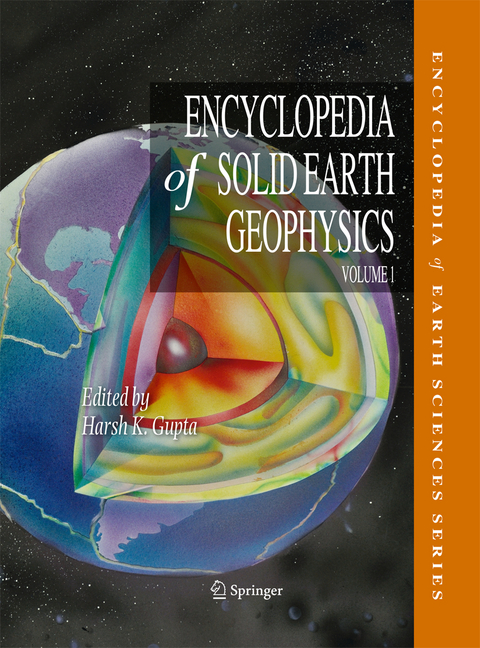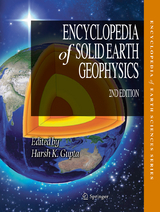Encyclopedia of Solid Earth Geophysics
Springer (Verlag)
978-90-481-8701-0 (ISBN)
- Titel erscheint in neuer Auflage
- Artikel merken
The first edition of the Encyclopedia of Solid Earth Geophysics was published in 1989 by Van Nostrand Reinhold publishing company. More than two decades later, this new volume, edited by Prof. Harsh K. Gupta, represents a thoroughly revised and expanded reference work. It brings together more than 200 articles covering established and new concepts of Geophysics across the various sub-disciplines such as Gravity, Geodesy, Geomagnetism, Seismology, Seismics, Deep Earth Processes, Plate Tectonics, Thermal Domains, Computational Methods, etc. in a systematic and consistent format and standard. It is an authoritative and current reference source with extraordinary width of scope. It draws its unique strength from the expert contributions of editors and authors across the globe. It is designed to serve as a valuable and cherished source of information for current and future generations of professionals.
Harsh K. Gupta currently holds the prestigious Panikkar Professorship at the National Geophysical Research Institute (NGRI), Council of Scientific & Industrial Research (CSIR), Hyderabad, India. Pursuing a luminous career in a variety of aspects of the Earth Sciences for over four decades, he is globally known for providing the first geophysical evidence of an enormously thick crust below the Himalaya and Tibet Plateau region, identifying the common characteristics of artificial water reservoir triggered earthquakes and discriminating them from normal earthquakes, setting up India’s first permanent station at Antarctica in a record time, and in recent years, spearheading the designing and commissioning of the Tsunami Warning System for India, after the disastrous tsunami caused by the 26th December 2004 Sumatra earthquake. He has published over 200 papers and written 4 pioneering books, published by Elsevier. Dr. Gupta has occupied several important positions including the Secretary to the Government of India, Department of Ocean Development and Director of NGRI. He is the founder President of the Asian Seismological Commission, and currently the President of the Geological Society of India, President of Asia Oceania Geosciences Society and Vice President of IUGG. His many honors and accolades include the USSR Academy of Sciences ‘100 years of International Geophysics’ Memorial Medal; Waldo E. Smith Medal of American Geophysical Union as well as the highest scientific and civilian honors from India, such as the Bhatnagar Award and the Padmashri Award.
Archeomagnetism.- Asthenospheric flows.- Continental collision.- Continental crustal structure.- Continental margins.- Continental rifting.- Controlled source EM surveys.- Convection, secondary instabilities.- Convolution.- Core, anisotropy.- Core, convection.- Core, differential rotation.- Core, dynamo.- Core, light elements.- Core, magnetic field.- Core, solidification.- Core, structure.- Core, temperature.- Core, viscosity.- Core-mantle interaction.- Curie temperature.- Decomposition.- De-convolution.- Deep drilling, continental.- Deep drilling, oceanic.- Density distribution of the Earth.- Earth tides.- Earthquake, depth distribution.- Earthquake, fault mechanism.- Earthquake, focal mechanisms.- Earthquake, forecast.- Earthquake, intensity, magnitude, energy.- Earthquake, location techniques.- Earthquake, precursors.- Earthquake, prediction.- Earthquake, strong ground motion.- Earth's thermal structure.- Elasticity theory, anisotropy.- Elasticity theory, elastic constants.- Elasticity theory, seismic waves.- Elasticity theory, stress and strain.- Electrical conductivity structure of the Earth.- Electrical properties of rocks.- Electrical resistivity surveys.- Energy budget of the Earth.- Energy partition of seismic waves.- Forward problem.- Fractal and chaos.- Free oscillations of the Earth.- Full waveform tomography.- Geodesy, figure of the earth.- Geodesy, ground positioning and leveling.- Geodesy, networks and reference system.- Geodesy, physical.- Geodynamics.- Geoelectricity.- Geoelectromagnetism.- Geoid, determination.- Geoid, interpretation.- Geoid, principles.- Geoid, stress and strain.- Geoid, tectonic forces.- Geomagnetic field, secular variation.- Geomagnetic field, global pattern.- Geomagnetic field, IGRF.- Geomagnetic field, theory.- Geomagnetic polarity reversals.- Global heat flow distribution.- Global Positioning System (GPS).- GPS, data reduction.- GPS, global plate motion models.- GPS, Reference models.- Gravimeters, Absolute.- Gravimeters,Relative.- Gravity data acquisition, Airborne.- Gravity data acquisition, Satellite.- Gravity data acquisition, Surface.- Gravity data, advanced processing.- Gravity data, reduction.- Gravity data, regional - residual separation.- Gravity field of the earth.- Gravity method, principles.- Gravity response of simple geometries.- Gravity, anomalies.- Gravity, Gradiometry.- Gravity, Interpretation.- Gravity, temporal variations.- Heat flow - age relationship.- Heat flow - heat generation relationship.- Heat flow measurements.- Heat transport mechanisms.- Impact crators.- Instrumentation, electrical.- Instrumentation, EM.- International gravity formula.- Interpretation of electrical resistivity data.- Interpretation, temporal variations of.- Inverse problem.- Inverse theory, Artificial Neural Network.- Inverse theory, Genetic algorithm.- Inverse theory, linear.- Inverse theory, nonlinear.- Inverse theory, non-uniqueness of solution.- Inverse theory, Singular Value.- Isostasy.- Length of day.- Lithosphere – Asthenosphere boundary.- Lithosphere, continental.- Lithosphere, cratons and mobile belts.- Lithosphere, mechanical properties.- Lithosphere, oceanic.- Lithospheric flexure.- Magmatic processes.- Magnetic data acquisition, Airborne.- Magnetic data acquisition, Satellite.- Magnetic data acquisition, Surface.- Magnetic data, Interpretation.- Magnetic data, Reduction.- Magnetic gradiometry.- Magnetic methods, Principles.- Magnetic properties of rocks and minerals.- Magnetic response of simple geometries.- magnetics.- Magnetometers.- Mantle plumes, convection.- Mantle plumes, hotspots.- Mantle plumes, partial melting.- Mantle plumes, structure.- Mantle, anisotropy.- Mantle, convection.- Mantle, D" layer.- Mantle, electrical structure.- Mantle, phase transitions.- Mantle, rheology.- Mantle, seismic tomography.- Mantle, structure.- Mantle, temperature.- Micro-seismicity.- Mid-oceanic ridges, convection.- Mid-oceanic ridges, gravity anomaly.- Mid-oceanic ridges, structure.- Mid-oceanic ridges, thermal structure.- Mid-oceanic ridges, tomographic images.- Mid-oceanic ridges, volcanism.- MT interpretation.- MT static effects.- MT time series analysis.- Natural EM source fields.- Natural source EM surveys.- Noise in geophysical data.- Numerical methods, Boundary Element.- Numerical methods, Domain decomposition.- Numerical methods, Finite Difference.- Numerical methods, Finite Element.- Numerical methods, Multigrid.- Paleomagnetism, Magnetostratigraphy.- Paleomagnetism, observations.- Paleomagnetism, theory.- Paleoseismology.- Paleo-temperatures.- Past plates reconstructions.- Plate driving forces.- Plate motion and climate change.- Plate tectonics.- Poroelasticity.- Potential fields, spherical harmonic analysis.- Pressure-Temperature-time paths.- Radiometric dating.- Remnant magnetization.- Remote sensing.- Rock magnetism.- SAR interferometry.- Sedimentary basins formation.- Seismic anisotropy.- Seismic attenuation.- Seismic data, acquisition techniques.- Seismic data, processing.- Seismic data, travel time inversion.- Seismic hazard assesment.- Seismic instrumentation.- Seismic microzonation.- Seismic migration: Theory and algorithms.- Seismic structure, global models.- Seismic tomography.- Seismic velocity - temperature relationship.- Seismic velocity-density relationship.- Seismic waves in the Earth.- Seismic, imaging.- Seismic, instrumentation.- Seismic, properties of rocks.- Seismic, ray theory.- Seismic, Receiver function technique.- Seismic, scattering.- Seismic, source wavelet.- Seismic, waveform modelling and inversion.- Seismicity, global.- Seismicity, intraplate.- Seismicity, triggered / induced.- Seismo-electromagnetic precursors.- Seismogram.- Seismological networks.- Seismometer and seismograph.- Slow earthquakes.- Sources of heat in the earth.- Stress in lithosphere.- Subduction zones, convection.- Subduction zones, detachment.- Subduction zones, gravity anomaly.- Subduction zones, structure.- Subduction zones, thermal structure.- Subduction zones, tomographic images.- Subduction zones, volcanism.- Surface paleo-temperatures estimation.- Surface wave dispersion.- Thermal isostasy.- Thermal properties of rocks.- Lithospheric imaging, integrated methods.- Time-lapse seismics.- Tsunami.- Vertical crustal movements.- Vertical seismic profiling.- Very Long baseline Interferometry (VLBI).- Wavelet analysis.- Well logging.
| Erscheint lt. Verlag | 29.6.2011 |
|---|---|
| Reihe/Serie | Encyclopedia of Earth Sciences Series | Encyclopedia of Solid Earth Geophysics | 1.10 |
| Mitarbeit |
Mitglied der Redaktion: Kusumita Arora, Anny Cazenave, Eric Robert Engdahl, Rainer Kind |
| Zusatzinfo | LXXIV, 1539 p. In 2 volumes, not available separately. |
| Verlagsort | Dordrecht |
| Sprache | englisch |
| Maße | 210 x 279 mm |
| Themenwelt | Schulbuch / Wörterbuch ► Lexikon / Chroniken |
| Naturwissenschaften ► Biologie ► Ökologie / Naturschutz | |
| Naturwissenschaften ► Geowissenschaften ► Geologie | |
| Naturwissenschaften ► Geowissenschaften ► Geophysik | |
| ISBN-10 | 90-481-8701-X / 904818701X |
| ISBN-13 | 978-90-481-8701-0 / 9789048187010 |
| Zustand | Neuware |
| Informationen gemäß Produktsicherheitsverordnung (GPSR) | |
| Haben Sie eine Frage zum Produkt? |
aus dem Bereich





